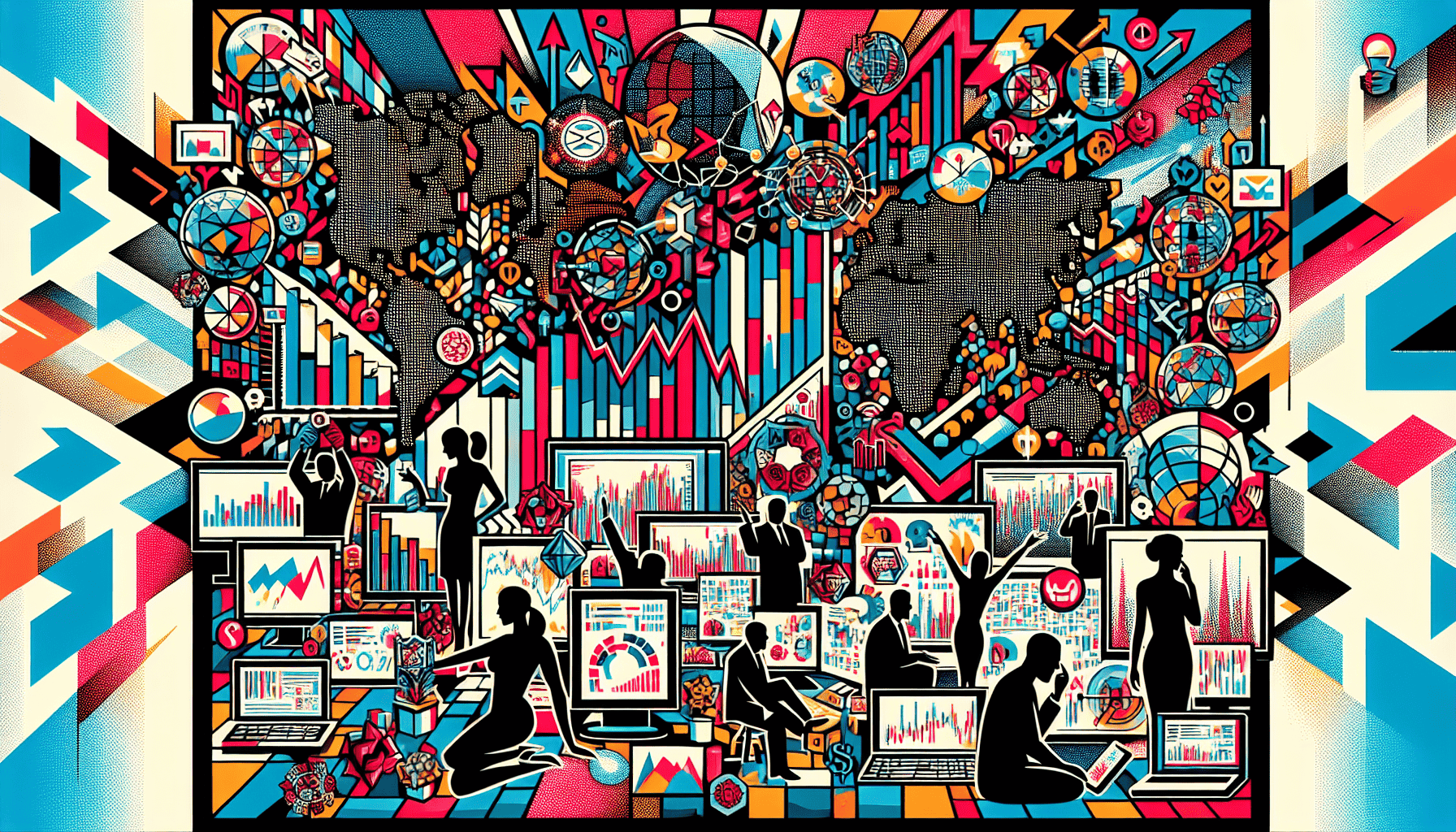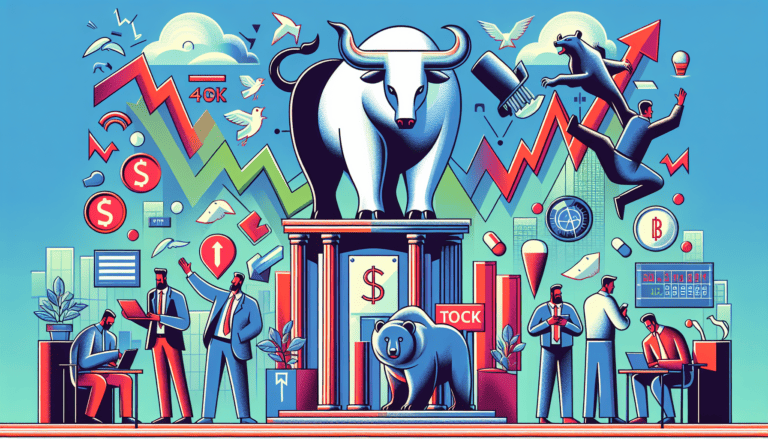Electronic Trading and Its Impact – Navigating the Digital Frontier

Introduction to Electronic Trading
The financial landscape has undergone a significant transformation with the advent of electronic trading. This technological evolution has redefined how securities are bought and sold in the financial markets, affecting not just institutional investors but also individual participants.
Evolution of Trading Platforms
Electronic trading has emerged as a cornerstone of modern finance, replacing paper-based and floor trading systems with sophisticated digital platforms. The transition from the bustling trading floors of stock exchanges to the quiet precision of computer-based trading has been driven by the pursuit of speed, accuracy, and efficiency in financial transactions. These platforms have not only accelerated the pace at which trading occurs but have also introduced a level of accessibility previously unavailable to the average investor.
Advancements in electronic trading technology have facilitated the development of new trading strategies and financial products, such as algorithmic trading and exchange-traded funds (ETFs). These innovations have reshaped the market landscape, leading to a more dynamic and fluid exchange environment.
One of the pivotal changes brought about by electronic trading is the reduction in the time required for settlement—from days to mere seconds (BIS). This leap in efficiency has enabled traders to execute multiple transactions within fractions of a second, a feat that was unimaginable in the era of traditional trading.
Electronic vs. Traditional Trading
The distinction between electronic trading and traditional trading lies in the methodology and speed of transaction execution. Traditional trading often involved face-to-face interactions, where trades were conducted on the physical trading floor of an exchange. This method was relatively slow and prone to human error. In contrast, electronic trading utilizes computer networks to match buyers and sellers, allowing for real-time trading and faster execution of orders without the need for human intervention.
Electronic trading has also impacted market efficiency, narrowing bid-ask spreads and improving price discovery through continuous and instantaneous market data updates. Moreover, it has reduced the role of intermediaries significantly, leading to lower transaction costs for market participants.
For beginner investors interested in learning more about the foundations of financial markets, electronic trading represents an important aspect to understand. It has democratized access to markets, allowing for a more inclusive investing environment. To further explore the intricacies of financial markets, including electronic trading’s role, readers can delve into topics such as understanding stock exchanges, major global stock exchanges, and initial public offerings (IPOs).
By mastering the digital frontier of electronic trading, investors can better navigate the complexities of the stock markets and take advantage of the myriad opportunities it presents.
Impact on Market Efficiency
Electronic trading has ushered in a new era of market efficiency, significantly transforming the way financial markets operate. The advent of digital platforms and trading technologies has optimized the transaction process, leading to numerous benefits for the market and its participants.
Faster Transactions
One of the most notable impacts of electronic trading is the acceleration of transaction speed. Traditional methods of trading involved more time-consuming processes, often requiring several days for settlement. With electronic trading, the settlement time has been reduced from days to mere seconds, enabling real-time trading and faster execution of orders. This rapid pace allows traders to take advantage of market opportunities as they arise, promoting a more dynamic and responsive trading environment.
| Traditional Trading | Electronic Trading |
|---|---|
| Settlement period of several days | Settlement in seconds |
| Slower response to market changes | Immediate execution of trades |
Improved Price Discovery
The efficiency of electronic trading platforms has also enhanced the process of price discovery. Price discovery is the mechanism by which markets determine the price of an asset, reflecting all available information. The use of electronic and algorithmic trading systems has led to narrower bid-ask spreads, which is the difference between the buy and sell prices offered in the market. This tightening of spreads contributes to a more accurate and transparent pricing of securities, benefiting all market participants (Source).
Reduced Transaction Costs
Another significant advantage of electronic trading is the reduction in transaction costs. The automation of trades and the elimination of many manual processes have decreased the costs associated with trading activities. Lower transaction costs make it more feasible for a broader range of investors, especially those with smaller capital, to participate in the market, thus democratizing investing and enhancing market liquidity.
The table below summarizes the impact of electronic trading on transaction costs:
| Aspect | Traditional Trading | Electronic Trading |
|---|---|---|
| Brokerage Fees | Higher due to manual processes | Lower due to automation |
| Bid-Ask Spreads | Wider | Narrower |
| Accessibility | Limited | Broadened |
Electronic trading has undoubtedly had a profound impact on market efficiency, offering faster transactions, improved price discovery, and reduced transaction costs. These advancements contribute to a more equitable and accessible financial landscape, encouraging participation from a wider audience of investors. As the finance industry continues to evolve, the role of electronic trading in promoting efficient markets is expected to grow, shaping the future of financial markets and exchanges.
Access and Liquidity
The advent of electronic trading has revolutionized access to financial markets and has significantly enhanced liquidity. This transformation has implications for both individual investors and the broader market structure.
Global Market Participation
Electronic trading has flattened the globe, allowing individual investors to access major global stock exchanges with ease. The rise of online trading means that individuals can now engage in buying and selling stocks from the comfort of their homes, which was once the exclusive domain of professional traders and large financial institutions. This increased access has also boosted participation in initial public offerings (IPOs) and other investment opportunities that were not as readily available to the average investor in the past.
Increased Market Liquidity
Electronic trading platforms have been instrumental in enhancing market liquidity. With more participants able to trade more efficiently, the volume of transactions has increased. This uptick in trading activity translates into more liquid markets, where buying and selling can occur more rapidly and with less price impact. The enhanced liquidity benefits all market participants, fostering a more dynamic and responsive trading environment.
Democratized Investing
Perhaps the most profound impact of electronic trading is the democratization of investing. Electronic trading has leveled the playing field, providing individual investors with tools and capabilities that were previously reserved for institutional traders (EPAM Solutions Hub). Now, investors have access to a wide range of investment options—including stocks, bonds, mutual funds, and ETFs—allowing for greater portfolio diversification and personalized investment strategies (Seattle Times).
The move towards electronic trading platforms has also prompted a reduction in transaction costs, making market participation more affordable (Seattle Times). This cost-effectiveness, combined with the convenience and accessibility of online trading, has attracted a new wave of investors, contributing to a more inclusive and diverse financial ecosystem.
In conclusion, electronic trading and its impact have transformed the landscape of financial markets, enhancing global participation, liquidity, and democratized access to investment opportunities. As electronic trading continues to evolve, it is likely to further empower individuals and reshape the dynamics of market participation. For those new to investing, understanding the mechanics of stock trading and stock market analysis techniques will be key components of successful navigation in the digital financial frontier.
Advantages for Individual Investors
The landscape of investing has been transformed by electronic trading, offering numerous advantages that cater particularly to individual investors. These benefits include more accessible market entry, a broader array of investment vehicles, and the ability to analyze market data in real-time.
Lowered Barriers to Entry
Electronic trading has significantly lowered the barriers to entry for individual investors. With the advent of online platforms, the process of buying and selling stocks has become more straightforward and convenient. According to a report by Seattle Times, the number of households in the US participating in online investing increased from 9.4 million in 2010 to 14.3 million in 2020. This surge reflects the ease with which individuals can now engage with financial markets from the comfort of their homes, using computers or mobile devices.
Moreover, the reduction in transaction costs associated with electronic trading means that investing is now more affordable for the average person. Lower fees enable individual investors to execute trades without the burden of high costs eating into their potential profits.
Diverse Investment Options
Electronic trading platforms have opened up a world of diverse investment options to individual investors. They can access a wide range of financial instruments, including, but not limited to, stocks, bonds, mutual funds, and exchange-traded funds (ETFs). This variety allows investors to build diversified portfolios tailored to their risk tolerance and investment goals. For further insights on the variety of investment options available, explore our resources on major global stock exchanges and exchange-traded funds (ETFs) in stock markets.
Real-Time Data Analysis
The ability to analyze market data in real-time is another significant advantage provided by electronic trading. Individual investors can now access up-to-the-minute information, which is crucial for making informed decisions. This access to real-time data levels the playing field between individual and institutional investors, as it was previously a resource only available to the latter group.
Online trading platforms often include tools and resources for stock market analysis techniques, allowing investors to perform technical analysis, track market trends, and stay updated on news that may affect their investments. By harnessing these tools, individual investors can make data-driven decisions to optimize their investment strategies.
To summarize, electronic trading has empowered individual investors with lower entry barriers, a plethora of investment opportunities, and the capacity to analyze real-time data comprehensively. This democratization of the financial markets has led to a more inclusive investing environment, enabling more people to participate in wealth-building activities. Those interested in further exploring the mechanics and intricacies of the stock market can delve into topics such as initial public offerings (IPOs) and the mechanics of stock trading.
Risks and Challenges
While electronic trading has transformed the financial markets, making them more accessible and efficient, it also introduces several risks and challenges. Investors, especially those new to the investment world, must be aware of these potential pitfalls.
Market Volatility
Electronic trading can lead to increased market volatility due to the speed at which trades can be executed. The lack of personal interaction and guidance from brokers, as mentioned by Seattle Times, means that individual investors may make hasty decisions based on rapid price changes. Additionally, “herding” behavior among algorithmic traders can exacerbate market movements, leading to extreme fluctuations in stock prices.
Understanding market trends and cycles (stock market trends and cycles) and having a solid grasp on the mechanics of stock trading can help mitigate some risks associated with market volatility.
Cybersecurity Concerns
The shift towards electronic trading platforms has brought cyber threats to the forefront of investment risks. Cybersecurity concerns include the potential for hacking, data breaches, and market manipulation. Regulatory bodies have been working to strengthen the security of trading systems, but the risks remain significant. EPAM Solutions Hub highlights the ongoing efforts to ensure the integrity of electronic trading systems amidst these cyber threats.
Investors should be diligent about the security of their online trading accounts and stay informed about stock market regulation and oversight to understand the measures in place to protect their investments.
Regulatory Considerations
Electronic trading has raised questions about market integrity and the adequacy of existing regulatory frameworks. The potential for technological failures and glitches can disrupt trading activities, leading regulatory bodies to implement measures aimed at safeguarding the markets. Source discusses the challenges of ensuring fair and transparent trading in the digital age.
Investors should educate themselves on regulatory considerations and how they impact the markets. This includes understanding the role of initial public offerings (IPOs), stock market indices, dividends, and bull and bear markets in the context of electronic trading.
In conclusion, electronic trading has undoubtedly provided numerous benefits to investors, but it also comes with its own set of risks and challenges. By staying informed and vigilant, investors can navigate these risks and make the most of the opportunities that electronic trading offers.
Algorithmic Trading and High-Frequency Trading
The financial markets have evolved significantly with the advent of electronic trading, leading to the rise of sophisticated trading strategies such as algorithmic trading and high-frequency trading (HFT). These methods have far-reaching implications for market dynamics and stability.
Role of Algorithms in Trading
Algorithmic trading involves the use of complex algorithms to automate trading strategies that can execute orders in a fraction of a second. These systems analyze market data, execute trades at optimal prices, and manage risks much faster than any human could. The introduction of algorithmic trading has transformed the landscape of financial markets, increasing the speed and efficiency of transactions.
However, these automated systems also bring challenges. The speed at which they operate can amplify market movements, especially when many algorithms follow similar strategies. This “herding” behavior among algorithmic traders can lead to increased market volatility and sometimes, unintended market disruptions (Source).
High-Frequency Trading Volume
High-frequency trading (HFT) is a subset of algorithmic trading characterized by extremely short holding periods, often just fractions of a second. HFT firms utilize advanced technological tools to execute a large number of trades rapidly. According to the BIS, HFT accounts for a significant portion of trading volume in equity markets, with estimates ranging from 35% to 70% of total trading volume.
| Market | Estimated HFT Volume |
|---|---|
| Equity Markets | 35% – 70% |
HFT contributes to the high liquidity and reduced bid-ask spreads observed in modern markets. The ability of HFT firms to quickly adjust prices to news ensures that stock prices reflect the latest market information, contributing to the overall efficiency of the markets.
Market Stability and Flash Crashes
While HFT and algorithmic trading have brought about increased efficiency, they have also been associated with market instability events, such as the “Flash Crash” of 2010. During this event, stock prices experienced an unprecedented and rapid decline before recovering within minutes. The BIS cites this incident as an example of the potential risks associated with electronic trading.
The inherent speed of these trading methods can sometimes result in aggressive price changes if algorithms react to the same market signals simultaneously. Flash crashes highlight the need for ongoing monitoring and potentially, additional regulatory measures to ensure market stability and protect investors.
As electronic trading continues to dominate financial markets, understanding the mechanisms behind algorithmic and high-frequency trading becomes increasingly important for investors. For those new to the investment world, gaining a foundational knowledge of stock market analysis techniques and the mechanics of stock trading can equip them with the tools to navigate this digital frontier confidently.
Furthermore, as the landscape evolves, investors must stay informed about stock market regulation and oversight to understand how changes may affect their investment strategies. It is essential to recognize both the opportunities and risks that come with these advanced trading technologies in order to manage stock market risks effectively.
The Future of Electronic Trading
The landscape of financial markets continues to evolve with the advancements in electronic trading technology. Looking ahead, several key areas are poised to shape the future of trading in the digital age. This section will explore the anticipated technological progress, the imperative of market integrity and transparency, and the crucial role of investor education in adapting to the electronic trading environment.
Technological Advancements
As electronic trading matures, the financial industry can expect to see significant technological innovations that will further streamline the trading process. These advancements are likely to include more sophisticated algorithms, enhanced artificial intelligence (AI) applications, and greater integration of blockchain technology, which could revolutionize the way trades are executed and recorded.
The development of new trading strategies and financial products, such as algorithmic trading and exchange-traded funds (ETFs), is also expected to continue, driven by these technological improvements (Fastercapital). The integration of AI and machine learning could lead to more adaptive and intelligent trading systems capable of analyzing vast amounts of data to make real-time decisions.
Market Integrity and Transparency
Maintaining the integrity and transparency of financial markets is essential to foster investor confidence and ensure fair trading practices. As electronic trading platforms become more prevalent, regulatory bodies are focusing on implementing measures to mitigate risks such as cyber threats and potential market manipulation.
Regulators are likely to enhance oversight mechanisms and develop new rules to govern the electronic trading ecosystem. These measures aim to prevent technological failures and glitches that can disrupt market activities, as well as to deter and detect any fraudulent activities that could compromise market integrity.
Investor Education and Adaptation
The shift towards electronic trading has made markets more accessible to individual investors, effectively democratizing access to the financial world. However, this ease of access also requires that investors are well-informed about the complexities of electronic trading and the associated risks.
Investor education will play a pivotal role in equipping traders with the knowledge to navigate the digital trading frontier successfully. Resources focusing on understanding stock exchanges, initial public offerings (IPOs), and market capitalization will be crucial. Additionally, guidance on managing stock market risks and understanding market trends and cycles will help investors make informed decisions in a fast-paced electronic trading environment.
The future of electronic trading is poised to be shaped by these three pillars: technological advancements, market integrity, and investor education. As the landscape evolves, staying abreast of changes and understanding the implications of these shifts will be imperative for anyone involved in the financial markets, from novice investors to seasoned professionals.





